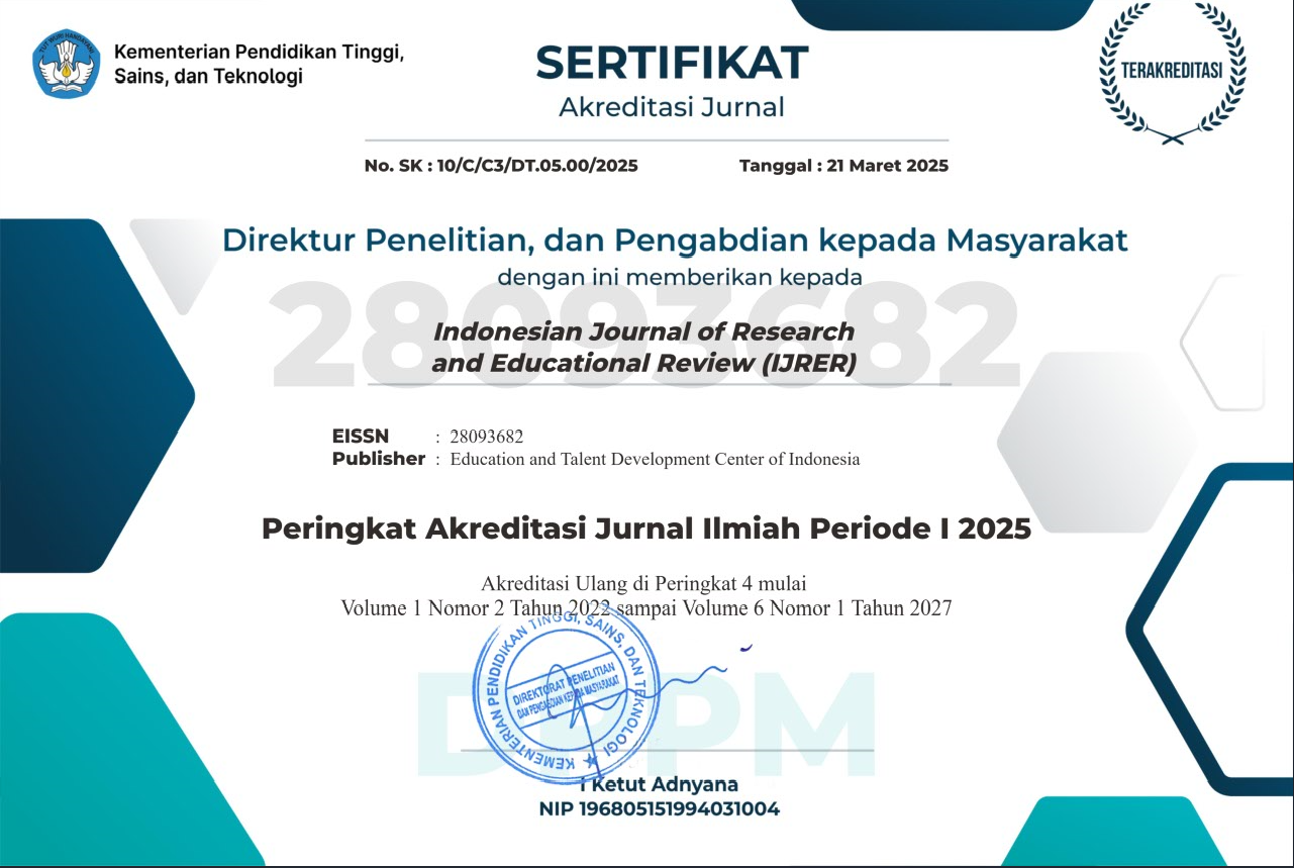Development of Laban Notation Learning Design Based on Direct Instruction Model in Higher Education
https://doi.org/10.51574/ijrer.v4i1.2766
Keywords:
Dance Notation Course, Direct Instruction, Higher Education, Instructional Design, LabanotationAbstract
This study's objective is to develop a Laban notation learning design based on the direct instruction model in dance notation courses. The research method used is Research and Development (R&D) with the 4-D Thiagarajan development model, which includes the stages of define, design, and development. This research was conducted at the Dance Study Program, Department of Performing Arts, Faculty of Arts and Design, Makassar State University. Data were collected through observation, questionnaires, literature studies, and expert validation. The results of the study indicate that based on the needs analysis, students have a high level of need for a more structured Laban notation learning design. The application of the direct instruction model is considered to be able to improve students' understanding of Laban notation. The Laban notation learning design based on direct instruction developed in this study produces a Semester Learning Plan (SLP) product. The results of expert validation show that the product meets the valid criteria, while the results of the trial show that this learning design is qualified and effective in improving students' understanding.
References
Ahmad, A., Schneider, J., Griffiths, D., Biedermann, D., Schiffner, D., Greller, W., & Drachsler, H. (2024). Connecting the dots–A literature review on learning analytics indicators from a learning design perspective. Journal of Computer Assisted Learning, 40(6), 2432-2470.
Barut Tugtekin, E., & Dursun, O. O. (2022). Effect of animated and interactive video variations on learners' motivation in distance Education. Education and Information Technologies, 27(3), 3247-3276.
Brown, A. H., & Green, T. D. (2019). The essentials of instructional design: Connecting fundamental principles with process and practice. Routledge.
Calissendorff, M., & Jaresand, S. (2023). ‘Listening is done by using all the senses’a study of how dancers create, communicate and perceive a choreographed dance. Research in Dance Education, 1-13.
Cao, X. (2024). Case study of China’s compulsory education system: AI apps and extracurricular dance learning. International Journal of Human–Computer Interaction, 40(13), 3419-3426.
Dania, A., Tyrovola, V., & Koutsouba, M. (2017). From symbols to movement:‘LANTD’, the design and implementation of a Laban notation-based method for teaching dance. Research in Dance Education, 18(1), 70-89.
Davies, E. (2007). Beyond dance: Laban's legacy of movement analysis. Routledge.
de Jong, T., Lazonder, A. W., Chinn, C. A., Fischer, F., Gobert, J., Hmelo-Silver, C. E., ... & Zacharia, Z. C. (2023). Let's talk evidence–The case for combining inquiry-based and direct instruction. Educational Research Review, 39, 100536.
Elvandari, E. (2019). Penerapan Metode Resitasi Dalam Pembelajaran Notasi Tari Pada Program Studi Pendidikan Sendratasik Universitas PGRI Palembang. Jurnal Sitakara, 4(2), 54-62.
Gropper, G. L. (2018). A lesson based on a behavioral approach to instructional design. In Instructional theories in action (pp. 45-112). Routledge.
Hasbi, M., Lukito, A., & Sulaiman, R. (2019). The Realistic Mathematics Learning Approach Improving the Ability of the Mathematical Connection of Junior High School Students at Al-Islamiyah Putat-Tanggulangin Sidoarjo.
Hsia, L. H., & Hwang, G. J. (2021). Enhancing students’ choreography and reflection in university dance courses: A mobile technology‐assisted peer assessment approach. British Journal of Educational Technology, 52(1), 266-287.
Hodges, C. B., & Kirschner, P. A. (2024). Innovation of instructional design and assessment in the age of generative artificial intelligence. TechTrends, 68(1), 195-199.
Kassing, G., Jay-Kirschenbaum, D., & Jay, D. M. (2021). Dance teaching methods and curriculum design: comprehensive K-12 dance education. Human Kinetics Publishers.
Khaerah, M. (2022). Tari Pajaga Makkunrai Versi Dinas Pendidikan Dan Kebudayaan Kabupaten Wajo (Sebuah Catatan Sistem Notasi Laban) (Doctoral dissertation, Fakultas Seni dan Desain).
Loring, D., & Pentz, J. (2021). Dance Appreciation. Human Kinetics.
Lu, M. C. (2009). The dance notation bureau. Dance Chronicle, 32(2), 291-301.
Mason, L., & Otero, M. (2021). Just how effective is direct instruction?. Perspectives on Behavior Science, 44(2), 225-244.
Merrill, M. D. (2013). Instructional transaction theory: An instructional design model based on knowledge objects. In Instructional Design: International Perspectives I (pp. 381-394). Routledge.
Mesra, R. (2023). Research & development dalam pendidikan.
Pastore, S., & Pentassuglia, M. (2015). Teaching as dance: A case-study for teacher practice analysis. International Journal of Educational Research, 70, 16-30.
Petry, B., Mouton, H., & Reigeluth, C. M. (2018). A lesson based on the Gagne-Briggs theory of instruction. In Instructional theories in action (pp. 11-44). Routledge.
Rolf, K. R., & Slocum, T. A. (2021). Features of direct instruction: Interactive lessons. Behavior Analysis in Practice, 14(3), 793-801.
Sivarajah, R. T., Curci, N. E., Johnson, E. M., Lam, D. L., Lee, J. T., & Richardson, M. L. (2019). A review of innovative teaching methods. Academic radiology, 26(1), 101-113.
Soerel, B. F., Plaatsman, L. A., Kegelaers, J., Stubbe, J. H., van Rijn, R. M., & Oudejans, R. R. (2023). An analysis of teachers’ instructions and feedback at a contemporary dance university. Frontiers in Psychology, 14, 1133737.
Stockard, J., Wood, T. W., Coughlin, C., & Rasplica Khoury, C. (2018). The effectiveness of direct instruction curricula: A meta-analysis of a half century of research. Review of educational research, 88(4), 479-507.
Sumiani. (2020). Designing Laban Dance Notation Textbook Based on Step By Step Learning for Dance Students in the Department of Performing Arts. Makassar: ICSAT Proceeding. https://ojs.unm.ac.id/icsat/article/view/17616
Sweller, J., Zhang, L., Ashman, G., Cobern, W., & Kirschner, P. A. (2024). Response to De Jong et al.’s (2023) paper “Let's talk evidence–The case for combining inquiry-based and direct instruction”. Educational Research Review, 42, 100584.
Triana, D. D., & Yudha, R. P. (2021). Performance assessment through motion literation to assess the motoric skill of junior high school students based on laban notation. Harmonia: Journal of Arts Research and Education, 21(1), 35-42.
Whatley, S. (2017). Documenting dance: Tools, frameworks and digital transformation. Documenting performance: The context and processes of digital curation and archiving, 284-303.

Downloads
Published
How to Cite
Issue
Section
License
Copyright (c) 2025 ETDC: Indonesian Journal of Research and Educational Review

This work is licensed under a Creative Commons Attribution-ShareAlike 4.0 International License.

























